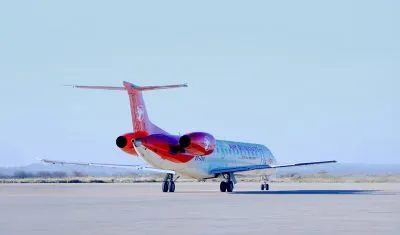There is no question that transport infrastructure is central to the development of African economies. A wide network of road, rail, air and sea connections eases the movement of freight, people and even ideas, promoting trade between neighbouring states, reducing the cost of goods and creating employment. After decades of stagnation, investment is now being made in a wide variety of transport projects by governments, investment agencies and, most strikingly, by private companies themselves.
Cargo volumes are continuing to grow strongly in all parts of Africa, particularly at the continent’s ports. The performance of Nigerian ports has been typical, with 40.6m tonnes handled during the first half of this year, up 10.17% on the same period last year.
Although there is still room for improvement, the various private sector companies that operate Nigerian port terminals under long-term concessions have invested heavily in new cargo handling equipment, while promoting more efficient operating methods. The Nigerian authorities have also put more effort into rooting out corrupt practices around the nation’s ports.
As trade between Africa and the rest of the world continue to grow, many governments and port operators are keen to position their ports as transshipment facilities. These are ports that receive cargo from one destination and then transfer it to other countries for distribution. They need to be large, efficient and with sufficiently deep waters to allow access for a wide range of different vessels.
For instance, the Mauritius Ports Authority (MPA) will launch a tender early next year to construct a new container terminal close to the island’s capital, Port-Louis. Construction costs are estimated at Rs20bn ($663m) and it is expected that the new facility will be operated by a joint venture of MPA and
a foreign partner.
With handling capacity of 2m 20-foot equivalent units (TEU)/year, it will be far bigger than the existing Mauritius Container Terminal (MCT), which can cope with up to 550,000 TEU/year. A TEU is a standard size container.
Transit cargo already accounts for 48% of all containers passing through the established port but the MPA hopes to take advantage of Mauritius’s growing role as a conduit for trade between the African and Asian continents.
Further north, the tiny state of Djibouti is basing its international trade strategy on its role as a transhipment centre. Both the Port of Djibouti and Doraleh Container Terminal are operated under 20-year concessions by DP World, which plans to expand Doraleh’s handling capacity from 1m TEU/year at present to 3m TEU/year.
A DP World spokesperson commented: “We see a bright future for Doraleh and with our partners will expand the terminal in line with market demand. No time line has yet been decided.”
DP World’s transhipment strategy has proved a success even at a time of high levels of pirate activity in the Indian Ocean, underlining the attractiveness of its location at the entrance to the Red Sea and on shipping lanes leading to the Suez Canal.
Although the government of Ethiopia is keen to secure access to other ports, including in Kenya and Somalia, Djibouti remains the main entrepôt for the landlocked country.
State-owned Ethiopian Petroleum Enterprise (EPE) has revealed that it will begin importing coal from South Africa, possibly as soon as next year. A consortium of the government, EPE, cement producers and the Ethiopian Maritime and Transit Services Enterprise have decided to import South African coal via Djibouti for use in the country’s cement plants, replacing more expensive oil feedstock.
Demand is expected to reach 1.5m tonnes a year by 2015.
Lowering costs is also the name of the game in Mozambique, where the government has appointed Sri Lankan firm Aitken Spence to improve efficiency levels at the port of Nacala, following on from the company’s recent work at the South African ports of Cape Town, Ngqura and Durban.
As with Beira, Nacala is expected to handle coal exports from Tete via a new railway that is scheduled for completion in 2014. In addition, a new container terminal is planned at what is regarded as the deepest natural harbour on the east coast of Africa. The port handled 71,112 TEU last year, up 34% on 2009.
Replicating the pattern established during the colonial era, most investment in African infrastructural projects is made to enable the transport of raw materials from inland areas to coastal ports and then from those ports to the rest of the world. Even in the aviation sector, more effort is put into securing services between Africa and non-African states than between neighbouring African countries. The lack of cross-border transport links has stifled the growth of internal African trade. However, as we report, new cross-border roads are beginning to be developed to encourage intra-African economic interaction, while dozens of airlines are launching services between African cities, as well as with the rest of the world.
From air to sea in Durban
By far the biggest planned new port project on the continent is the Transnet scheme to turn the former Durban International Airport into a new container terminal.
Durban Container Terminal is already the biggest in sub-Saharan Africa but the facility is running out of capacity and room for expansion, so Transnet is keen to develop a new 9m TEU/year terminal on land to the south of the port where Durban’s main airport was located until last year. It was closed as planned when King Shaka International Airport opened to the north of the city.
The portion of the former airport site required for the port is expected to cost up to R3bn ($383m) although the entire project carries an estimated price tag of R75bn ($9.6bn). Much will depend on the government’s willingness to direct Airports Company SA (ACSA) to complete the sale to fellow state-owned company Transnet. ACSA has debts of R16bn ($2bn), partly because of the cost of constructing the new airport, and could benefit from such a cash injection.
South Africa aside, private sector operators are gradually taking control of most port terminals on the continent. French firm Bolloré Africa Logistics (BAL) expects to resume its operations at the port of Misrata once the dust has settled in the Libyan civil war.
A BAL spokesperson said: “Libya’s Transitional National Council has indicated that all contracts signed before 17th February 2011 will be honoured, so there is plenty of room for optimism. However, we cannot say when the contract will begin, this being directly dependent on civil and economic life stabilising in Libya.”
The company was awarded a contract to operate Misrata Free Zone at the end of last year but there had been some doubt over whether contracts signed while President Muammar Gaddafi was still in power would be honoured.
However, BAL may have some reconstruction work to undertake, given that the port of Misrata came under repeated attack from pro-Gaddafi forces during the civil war, as it was the only major city to hold out against government forces for several months earlier this year.
Angolan investment takes off
Some of the continent’s fastest-growing economies are most actively upgrading their transport infrastructure. Despite criticism of the slow pace of development since the 2002 peace agreement, a wide range of projects are under development in Angola, from roads to rail and ports to airports.
President José Eduardo dos Santos announced in August that the first phase of the new Luanda International Airport would open next year. Once fully operational, the airport will be able to serve 15m passengers a year, far in excess of existing national demand. Located about 40km from Luanda, it will have two double runways of sufficient length to serve the world’s biggest passenger aircraft.
Although the new airport has attracted most of the attention, the government is keen to emphasise that some investment is being made in the rest of the country. In his State of the Nation speech in October, President Dos Santos said: “The refurbishment of airport facilities continues and the airports of Cabinda, Catumbela, Benguela, Malanje, Ondjiva, Lubango and Huambo have been modernised and Carianga airport, in Ndalatando is ready to be inaugurated.” Contracts to upgrade airports at Dundo, Luena and Saurimo are expected to be awarded in the near future.
The pace of railway redevelopment is also picking up in Angola, where all three main lines from coastal ports to the landlocked east of the country are being rehabilitated. Caminho de Ferro de Moçâmedes announced in September that about 70% of the Moçâmedes railway from the port of Namibe to Cuando Cubango Province had been reconstructed and the entire 970km railway would be completed early next year. Export Import Bank of China is helping to fund the $2bn project.
The line will be used to export iron ore and manganese from 2014, while passenger and container services will also be launched. Rail services recommenced on the Luanda line in January and on the first section of the 1,379km Benguela railway in January.
In addition to the rehabilitation of the country’s main railways, Angolan ports have also been upgraded. Since 2007, Sociedade Gestora de Terminais (Sogester) has invested $155m in new infrastructure, cargo handling equipment, IT systems and staff training at Luanda Container Terminal. Sogester is owned by Danish firm Maersk (11%) and its subsidiary APM Terminals (40%), with the remaining 49% equity held by Angolan state pension fund Gestao de Fundos.
Sogester deputy director Patrick Anderson said: “When we began in 2007, we were trying to create the conditions to turn the port of Luanda into a more efficient port. One of the port’s problems is its limited size, which makes our activities more difficult.”
The port of Luanda handles 85% of Angolan seaborne cargo but the government has long been keen to develop additional handling capacity outside the city.
In October, President Dos Santos revealed that the new port would be constructed at Barra do Dande, 50km north of Luanda. As in the rest of the continent, it will be interesting to see how much effort Luanda puts into integrating headline-grabbing new port and airport projects with the country’s wider transport infrastructure.
Want to continue reading? Subscribe today.
You've read all your free articles for this month! Subscribe now to enjoy full access to our content.
Digital Monthly
£8.00 / month
Receive full unlimited access to our articles, opinions, podcasts and more.
Digital Yearly
£70.00 / year
Our best value offer - save £26 and gain access to all of our digital content for an entire year!

 Sign in with Google
Sign in with Google 


